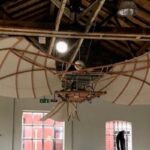The idea of building wings to imitate the birds’ flight comes from the ancient Greek legend of Icarus and Dedalus. The first attempt of mechanic flight was ascribed to Abbas Ibn Firnas, who threw a rudimental ornithopter from the Bride’s Mountain (Jabal al’Arus) in the area of Rusafa, near Cordova (Spain) in 875 a.d. Roger Bacon in 1260 was the first to consider the use of some kind of machine for human flight. Around 1490 Leonardo da Vinci started to study the birds’ flight and understood that human beings are too heavy and not strong enough to fly just using wings on their arms. Therefore he considered a machine in which the pilot was lying on a board and could move two big wings using arms, pedals and levers. The first Ornithopter able to fly was built in France in 1870. The model of Gustave Trouvé flew for a distante of 70 meters in a demonstration to the French Science Academy. The wings were moved by gunpowder that attivated pressure pipes. Jobert in 1871 used some elastic bands to make a little artificial bird fly. Alphonse Pénaud, Hureau de Villeneuve, Victor Tatin and others followed these projects. Around 1890, Lawrence Hargrave built various ornithopters moved by steam or compressed air, that powered the big static wings. In 1930, Erich von Holst used a rubber band to push bird models at a high development state and great realism. In the same year Alexander Lippisch and other researchers in Germany tested the use of an internal piston
engine.
The ornithopter exhibited at Volandia is a full scale model of Leonardo’s design.
Leonardo da Vinci Ornitottero
Aircrafts

Technical Specifications
Name :
Ornitottero
Family :
Fling Object Attempt
Manufacturer :
Leonardo da Vinci
Nation :
Italy
Production Year :
1490
Dimensions
Weights
Engines
Arms
Performances
History



